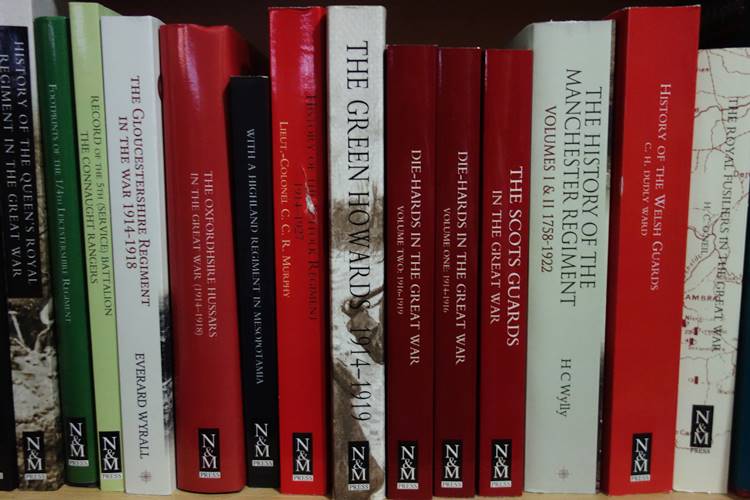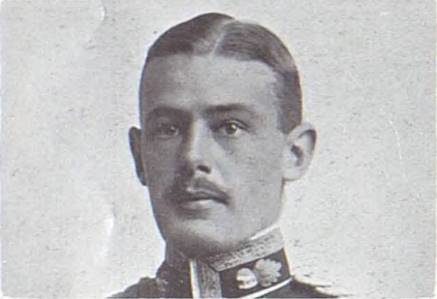This article explains how using divisional, regimental and battalion histories can help you research a soldier who served in the British and Indian Armies during the First World War. This is just one of dozens of guides I’ve written to researching soldiers who served in the war:
- Researching Soldiers who Served in the British Army
- Researching Soldiers who Served in the Indian Army
Using First World War Divisional, Regimental and Battalion Histories
Regimental, battalion and divisional histories are great resources to use if you are looking to research a soldier who served in the First World War. The years following the end of the First World War saw a wide variety of books published focusing on the activities of certain of units during the war. In recent years these have been supplemented by a large number of battalion histories, often published by Pen and Sword and usually focusing on territorial or war raised service battalions. The three types of histories you will come across are:
- Divisional Histories: These books are the least useful, as they concern the history of large numbers of battalions and supporting units. In 1914, a division was comprised of four brigades, each with four battalions with supporting units from the Royal Artillery, Royal Engineers, Army Service Corps etc. Therefore, units are often only mentioned briefly and individuals tend to be limited to senior officers and gallantry winners. However, they are very good for adding context, especially when the Division was engaged with the objectives of each brigade recorded and often very useful maps marking objectives. A good example is the History of the Guards Division in the Great War 1915-1918 by Cuthbert Headlam which is full of very useful maps covering the major battles. The Naval and Military Press has reprinted all divisional histories from the war.
- Regimental Histories: These histories can vary considerably in their quality and usefulness. Regimental histories for cavalry regiments are often very detailed and produced to a very high standard. They can even contain full casualtly lists of killed, wounded and prisoners. Those for infantry regiments can range from the excellent to the very poor. A particular problem for the those researching infantry battalions which did not serve outside of Britain and Ireland is the lack of information in histories. It is not unusual to find a home service battalion receiving less than a page giving the most scanty information. They are usually divided up by battalion or written chronologically. Officers are often mentioned and accounts of battles can be used to add more detail to a unit’s war diary entries. However, due to the number of battalions a regiment had the amount of detail can vary considerably.
- Battalion Histories: These are the most useful by far, as they concern themselves solely with the activities of a single battalion. Though they vary considerably in their content, they will usually contain detailed descriptions of the battalion’s movements, training, officers and experiences (not always related to fighting). While I have focussed on infantry battalions, a small number of unit histories were produced for Royal Artillery, Royal Army Service Corps etc. Unfortunately, the overwhelming majority did not produce a history.
How to Find the Correct Regimental or Battalion History
A Google search will usually enable you to quickly find out if there is a relevant regimental or battalion history. Just search the regiment you need with the words “regimental history” after it. If you have an interest in military history or plan to research a large number of soldiers, I would recommend, A Bibliography of Regimental Histories of the British Army, by Arthur S. White. This is a comprehensive volume and will ensure that you are able to locate all the relevant material. I have also included regimental histories in my guides to:
Most regimental histories are available to buy quite cheaply from Amazon or the Naval and Military Press. Due to their popularity, they can often be ordered at your local library. A few regimental histories are available to download for free as their copyrights have expired. Archive.org is a very good site to search for free online books.
Search Archive.org
Indian Army Regimental Histories
When trying to find Indian Army regimental histories remember to search for both its title during the First World War and after the reorganization of the Indian Army in 1922. The regimental histories may include both titles e.g. History of the 1st Battalion, 14th Punjab Regiment Sherdil-Ki-Paltan Late XIX Punjabis but many do not. My articles on Indian infantry and cavalry regiments will provide you with the lineage of each unit:
An excellent book cataloguing regimental histories of the Indian Army is Regiments of the Empire: A Bibliography of their Published Histories by Roger Perkins. You can often pick up a cheap copy on Amazon.
Due to their limited print runs, many Indian Army regimental histories can be very difficult to get hold of. If you live in London or nearby, I would recommend viewing them at the British Library which allows photography. Try to view first editions as these often contain maps which were lost in subsequent reprints and clearer photographs. The Naval and Military Press has reprinted a large number of Indian regimental histories, making them available to a wider audience. Below are some of the regimental histories in my own collection and all of those shown are recent reprints, with the majority published by the Naval and Military Press (N&M Press).
Advantages of Using Regimental Histories
A great advantage of using a unit’s history (though they can vary considerably in both their style of writing and detail), is they can provide far more information about an event than a unit’s war diary. The war diary was usually written by an Adjutant of a unit from notes kept daily and they can be very brief or even fail to mention important events which took place. Compare the war diary of the 2nd Battalion Yorkshire Regiment (Green Howards) near Ypres, Belgium on 16 October 1914 with The Green Howards in the Great War by Colonel H. C. Wylly describing the same incident:
War diary: A Company slightly engaged, and captured or killed eight German Hussars.
Colonel Wylly: The men had tea and breakfast and while this was going on a small patrol which had gone out from ‘A’ Company under Phayre came back very full of themselves, having captured a German patrol. They had gone down the road a bit and been fired on from a farmhouse, so they moved up against the place and saw about eight Germans run across the road from the house into the barn. They shot one as he was running… The remaining Germans were summoned to surrender, and as they flatly refused to do so, Phayre set the barn on fire. Eventually they came out, but not until their boots were nearly burnt off their feet; and when asked why they had not surrendered before, they said they had been told that the English always shot their prisoners!
Lieutenant Richard Herbert Phayre was killed in action ten days later aged 24. He is commemorated on the Ypres (Menin Gate) Memorial. This photograph of Lieutenant Phayre was published in The Sphere, 21 November 1914. The Sphere published thousands of photographs of officers during the war and can be searched on FindmyPast. Newspapers can be a key resource to use when researching soldiers.
Below is an example of how regimental histories can be used to add context to a soldier’s service. The quote is taken from, Regimental History of the 1st Battalion 8th Punjab Regiment, by Geoghegan and Campbell and describes the conditions faced by the 89th Punjabis in Mesopotamia (Iraq):
Since our arrival in Mesopotamia, numerous cases of sickness were reported. These were put down chiefly to the drinking of Tigris water, but the rain-soaked atta [flour] may have had a lot to do with it. No [tar] paulins were available to cover the men’s rations, with the result that they got into an awful state. To complete the discomfiture of the Medical Officer, an epidemic of mumps broke out in the Battalion. But, in spite of this and of all the hardships that were experienced, only twenty-four men had been transferred to the field ambulance since landing in Basra.


